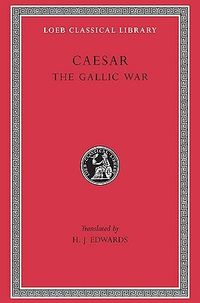
The Gallic War
A History, Classics, Nonfiction book. Accordingly tree trunks or very stout boughs were cut and...
Caesar (C. Iulius, 102-44), statesman & soldier, defied the dictator Sulla; served in the Mithridatic wars & in Spain; pushed his way in Roman politics as a 'democrat' against the senatorial government; was the real leader of the coalition with Pompey & Crassus; conquered all Gaul for Rome; attacked Britain twice; was forced into civil war; became master of the Roman world & achieved wide-reaching reforms until his murder. We have his books of Commentarii (notes): 8 on his wars in Gaul, 58-52, including the two expeditions to Britain 55-54 & 3 on the civil war of 49-48. They're records of his own campaigns (with occasional digressions) in vigorous, direct, clear, unemotional style in 3rd person, the account of the civil war being somewhat more impassioned. There is scant rhetoric. The Loeb Classical Library edition of Caesar is in 3 volumes....
Download or read The Gallic War in PDF formats. You may also find other subjects related with The Gallic War.
- Filetype: PDF
- Pages: 631 pages
- ISBN: 9780674990807 / 674990803
SJRMktYdFwZ.pdf
More About The Gallic War
The ground in front of his camp was ideal for deploying the army for action. The low hill on which the camp stood was of just the right width, on the side facing the enemy, for the legions to occupy in battle formation; on each flank it descended steeply to the plain, while in front it formed a slight ridge and then sloped gently down. On either side of the hill Caesar had a trench dug, running for about six hundred and fifty yards at right angles to the line along which the troops would be drawn up, and placed redoubts and artillery at both ends of... Gallic walls are always built more or less on the following plan. Balks of timber are laid on the ground at regular intervals of two feet along the whole line on which the wall is to be built, at right angles to it. These are made fast to one another by long beams running across them at their centre points, and are covered with a quantity of rubble; and the two-foot intervals between them are faced with large stones fitted tightly in. When this first course has been placed in position and fastened together, another course is laid on top. The same interval... Cuando lleguemos a ese ro, ya hablaremos de ese puente. Gaius Julius Caesar, The Conquest of Gaul
I think this book is worth reading and pondering since it's written by one of the famous Roman generals and statesmen in Latin. Long time ago I first read his decisive quote, "I came, I saw, I conquered!" [Veni, vidi, vici!] somewhere with awe and wondered who said this and why. We can still read about him in innumerable biographies... A very rich text! There are some aspects that caught my eyes but I feel that I'm incapable of elaborating on any of them, so I'll just pose a few question marks in my review.1. The control of passion.I kept hearing Carl von Clausewitz's voiceover throughout the book: "Gentlemen, feels are important!"There are many battles in the book... Since we no longer are required to take Latin in school, Caesar doesnt get read like he used to. If you take a course in the Ancient World or The Classical World or, even more specifically, Roman History, you are much more likely to be assigned Suetonius or Tacitus, even Robert Graves, than Caesar. Its a shame because Juilius could...











